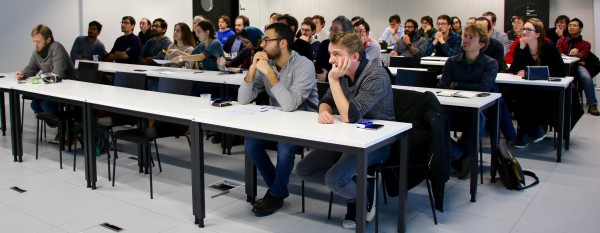MARVEL Junior Seminar — February 2022
https://epfl.zoom.us/j/68368776745
Password: 1923
Each seminar consists of two presentations of 25 minutes each, allowing to present on a scientific question in depth, followed by time for discussion. The discussion is facilitated and timed by the chair.

MARVEL Junior Seminar Organizing Committee — Michele Kotiuga, Sara Fiore, Stefano Falletta, Kristians Cernevics, Max Veit and Patrick Mayor
Talk 1 — Phonon-assisted luminescence in qubits from many-body perturbation theory
Francesco Libbi1, Pedro Miguel M. C. de Melo2,3,4, Zeila Zanolli2,4, Matthieu Verstraete3,4, Nicola Marzari1
1 Laboratory of Theory and Simulation of Materials (THEOS), Institute of Materials, EPFL
2 Chemistry Department, Debye Institute for Nanomaterials Science, Condensed Matter and Interfaces, Utrecht University (Netherlands)
3 nanomat/Q-mat/CESAM, Université de Liège (Belgium)
4 European Theoretical Spectroscopy Facility (ETSF) www.etsf.eu
Phonon-assisted luminescence is a key property of defect centers in semiconductors, and can be measured to perform the readout of the information stored in a quantum bit, or to detect temperature variations. The investigation of phonon-assisted luminescence usually employs phenomenological models, such as that of Huang and Rhys, with restrictive assumptions that can fail to be predictive.
In this work, we predict luminescence and study exciton-phonon couplings within a rigorous many-body perturbation theory framework, an analysis that has never been performed for defect centers. In particular, we study the optical emission of the negatively-charged boron vacancy in 2D hexagonal boron nitride, which currently stands out among defect centers in 2D materials thanks to its promise for applications in quantum information and quantum sensing. We show that phonons are responsible for the observed luminescence, which otherwise would be dark due to symmetry. We also show that the symmetry breaking induced by the static Jahn-Teller effect is not able to describe the presence of the experimentally observed peak at 1.5 eV.
Talk 2 — Increasing efficiency for theoretical absorption and emission spectroscopy of periodic systems
Anna Hehn1, Beliz Sertcan1, Fabian Belleflamme1, Sergey K. Chulkov2, Matthew B. Watkins2, Jürg Hutter1
1 Department of Chemistry, University of Zurich
2 School of Mathematics and Physics, University of Lincoln, UK
State-of-the-art computational approaches to describe photochemical processes in extended materials most often rely on time-dependent density functional theory, representing a well-established framework with high feasibility and robustness to enable broad applications. The description of exact exchange is thereby often required to achieve sufficient accuracy and we thus propose two efficient, approximate TDDFT schemes to reach hybrid functional accuracy, exploiting on the one hand the concept of the auxiliary density matrix method (ADMM) [1] and on the other hand the idea of semi-empirical tight binding within the so-called simplified Tamm-Dancoff approximation (sTDA) [2]: Among the existing techniques to improve the unfavorable basis-set dependence and thus high computational cost of exact Hartree-Fock exchange, ADMM has proven to be a reliable approach to achieve significant speedups, being based on the idea of constructing an auxiliary density matrix for the evaluation of the exact exchange term and correcting the thereby introduced error by a density functional contribution. The semi-empirical sTDA ansatz increases efficiency even further while having in contrast to other tight-binding approaches the advantage of relying only on global parameters and thus enabling broad applications. Both ADMM-approximated hybrid density functional theory and semi-empirical sTDA approaches were implemented in the TDDFT module of CP2K [3] and benchmarks on molecular and periodic systems show promising accuracy-cost ratios, demonstrating the suitability of both methods as alternatives to conventional hybrid functional TDDFT.
[1] M. Guidon, J. Hutter, J. VandeVondele, J. Chem. Theory Comput., 2010, 6, 2348
[2] S. Grimme, J. Chem. Phys., 2013, 138, 244104.
[3] T. D. Kühne et. al., J. Chem. Phys., 2020, 152, 194103.
Check the list of the next MARVEL Junior Seminars here.
Low-volume newsletters, targeted to the scientific and industrial communities.
Subscribe to our newsletter